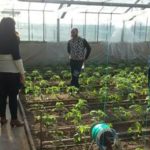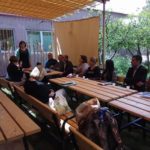Reviewed by the ”Rural Sustainable Development” Agricultural Foundation
Project title: The implementation of the WOMEN2030 programme in ARMENIA

The “Rural Sustainable Development” Agricultural Foundation was created in 2009 by the initiative of a group of young specialists and people who are interested in rural development. The mission of the organization is to contribute to the sustainable development of rural population, particularly women and children, ensure the active participation of the local population in the improvement of their living conditions, developing the perception of their rights to be healthy and live in a healthy environment through environmentally sound and sustainable agriculture.
Country context
The Republic of Armenia is a small landlocked country with population of less than 3 million. The GDP per capita was $3,880 in 2017.
Over the last decade, Armenia has undertaken wide-ranging and comprehensive institutional, economic and social reforms towards implementation of the Millennium Development Goals (MDGs). Overall, Armenia identified and committed to fulfill 16 national targets with 65 indicators in the process of MDG nationalization. Armenia has achieved 22 indicators and has had good progress towards another 10 indicators by 2015. The progress was weak in poverty reduction, gender equality (particularly women’s participation in decision-making), and governance areas.
Some of issues remain in environmental protection, such as deforestation risks, use of solid fuel by the population, availability and access to sanitation. The poverty level in Armenia is still high, with 30% of population below the poverty line.
In September 2015, the Government of Armenia signed on to Agenda 2030 and its 17 Sustainable Development Goals (SDGs). In May 2016, the Government launched the MDGs wrap-up report and formally kicked off the SDGs nationalization process with setting up also its architecture.
Employment rate for 2016 was 50%.
Married men are more than twice as likely as married women to be employed (89% versus 42%).
SDG Implementation Process in Armenia
Since 2015, Armenia has created necessary infrastructure for the implementation of the SDGs, such as National Council on Sustainable Development under the Prime Minister of Armenia, SDG Nationalization Inter-agency Task Force, Armenia National SDG Innovation Lab. The SDG Innovation Lab is an innovation platform/model where the Government and the UN are joining forces to support the implementation of the SDGs in the country. The National Statistical Service developed global metadata on all indicators which helps to assess current state of affairs with regard to the SDGs.
In May 2016, the Government started the SDGs nationalization process. For this purpose, the coordination structure and institutional framework were designed and four inter-agency thematic working groups were established.
In June 2017, the Government prepared its medium-term development programme, which established strong synergies with the SDGs. Furthermore, the Center for Strategic Initiatives was tasked to revise and update the Armenian Development Strategy transforming it to a long-term strategic development framework until 2030, incorporating into it emerging priorities and needs, integrating crosscutting and innovative approaches as both a vision and a methodological tool. The Armenia Development Strategy 2014-2025 sets the strategic goals, targets and indicators in multiple economic and social areas.
In June 2017, the Government expressed its interest to present the first Voluntary National Review (VNR) in July 2018 at the High-level Political Forum (HLPF).
In June 2018, the VNR was circulated to key stakeholders for their comments and inputs. The VNR was not ready for the wider dissemination and discussion. Furthermore, few CSOs, were involved in the consultation process. There is no national CSO coalition in the country.

Source: Rapid Policy Integrated Assessment in Armenia
Initial Findings on Selected Sustainable Development Goals and Targets
There are strong inter-linkages between SDGs 1, 5 and 6. Although, the Constitution and the legal framework of Armenia guarantee and promote equality and non‑discrimination on the basis of gender, women are not yet able to fully benefit from equal opportunities.
Women are less engaged in decision-making positions. For example, the proportion of women elected to the National Assembly of Armenia (Parliament) was 9.9 percent in 2017.
Examples of inter-linkages between goals 1, 5 and 6.
| Goal |
Target |
Indicator |
Year |
|
|
2015 |
2016 |
|||
|
Goal 1. End poverty in all its forms everywhere |
1.1 By 2030, eradicate extreme poverty for all people everywhere, currently measured as people living on less than $1,25 a day |
1.1.1 Proportion of population below the international poverty line by gender |
Male: 0,1% |
Male: 0,8% |
|
1.2 By 2030, reduce at least by half the proportion of men, women and children of all ages living in poverty in all its dimensions according to national definitions |
1.2.2 Proportion of men, women and children of all ages living in poverty in all its dimensions according to national definitions |
Male: 27,9% |
Male: 28,5% |
|
|
Goal 5. Achieve gender equality and empower all women and girls |
5.4 Recognize and value unpaid care and domestic work through the provision of public services, infrastructure and social protection policies and the promotion of shared responsibility within the household and the family as nationally appropriate |
5.4.1 Proportion of time spent on unpaid domestic and care work by gender, age and location |
Data are not available |
Data are not available |
|
Goal 6. Ensure availability and sustainable management of water and sanitation for all |
6.1 By 2030, achieve universal and equitable access to safe and affordable drinking water for all |
6.1.1 Proportion of population using safely managed drinking water services |
98,1% Sex-aggregated data are not available |
No data Sex- aggregated data are not available |
|
6.2 By 2030, achieve access to adequate and equitable sanitation and hygiene for all and end open defecation, paying special attention to the needs of women and girls and those in vulnerable situations |
6.2.1 Proportion of population using safely managed sanitation services, including a hand-washing facility with soap and water |
69,9% Sex-aggregated data are not available |
69,7% Sex-aggregated data are not available |
|
There are number of issues related to national data availability. To monitor and evaluate SDGs effectively, these issues shall be addressed. As an example shown in the table above, there are a considerable number of areas, where the national indicators, defined in policy/strategy documents, do not have a level of disaggregation by gender. Data on women’s time spent on unpaid domestic and care work, especially on the time spent because of lack of water and sanitation, should be addressed.
Recommendations from Civil Society, Women and other stakeholders resulting from the policy meeting on Armenian stakeholder dialogue on the 2030 Agenda for Sustainable Development
On 18 June 2018 the Rural Sustainable Development Agricultural Foundation organized a policy meeting on Armenian stakeholder dialogue on the 2030 Agenda for Sustainable Development in Yerevan, the capital of Armenia. The meeting was organized in partnership with WECF-International in the framework of Women 2030.
The policy meeting aimed to discuss:
- Provision of input to the Armenian VNR based on priorities of stakeholders, and
- Create strategic partnerships across actors to support the implementation and monitoring of the SDGs at national level.
The meeting was attended by 27 participants representing national stakeholders, such as the Ministry of Health, Ministry of Labor and Social Affairs, National SDG Innovation Lab, Armenian Statistical Service, International Organizations in Armenia (United Nations Development Programme /UNDP/ and Food and Agriculture Organization of the United Nations /FAO/), academia (Armenian State Pedagogical University /ASPU/), non-governmental organizations (NGOs) and independent experts.
During the meeting the following themes were presented: the national SDGs and what they mean for Armenia; preparations of the VNR to the United Nations HLPF 2018; civil society participation in preparation of national SDGs; Women2030 input to HLPF; implementation of SDG 6 in Armenia. Later, group discussions were organized on key challenges and best practices in Armenia.
After intensive discussion, the participants agreed on the VNR recommendations and input for the VNR intervention at the HLPF. The following priorities emerged:
– Phase out government support for unsustainable economic investments, in particular, in the mining area, and to make polluters pay (chemicals, heavy metals);
– Gender equality is still far for being achieved (SDG5) as Armenia has a particular low representation of women in higher level decision making;
– Many rural communities do not have access to safe water and sanitation. This should be a priority, including attention for menstrual hygiene management in schools and workplaces.
As a result from the policy dialogue meeting organized as part of the global Women2030 program, the following questions emerged:
- on environment:
-
- Armenia is increasingly a water-stressed country, and many communities do not have safe drinking water and adequate sanitation. The situation for rural areas is particularly problematic, especially in schools. How is the Government going to ensure the right to safe drinking water and sanitation for boys and girls?
- Regarding the environmental protection policies and standards, can the government policy for the mining sector be improved, halt pollution from harmful metals and chemicals and ensure mining sites will be cleaned up, paid for by the companies, not the tax payer?
- When will there be standards for secondary use of wastewater; and improved policies for solid waste management?
- on energy and housing:
-
- At least 30% of population in the country can be considered energy poor. Has the Government developed any methods to encourage investment by the financial sector in energy efficiency and renewable energy for the housing sector, including in rural areas?
- CSO engagement:
-
- The NGO sector appreciated the consultations held in advance of the HLPF. However, some civil society sectors were still missing: how will the Government engage a wider array of stakeholders in the future?
All participating organizations were interested to establish CSO platform/coalition on implementation of the SDGs.
References
- Rapid Policy Integrated Assessment in Armenia. Key Observations, Findings and Provisional Recommendations
- Implementation of the Sustainable Development Goals of the 2030 Agenda for Sustainable Development Voluntary National Review (VNR); Republic of Armenia Highlights
- “Rio + 20” National Assessment Report
- National Statistical Service
- Armenia: 2015-16 Demographic and Health Survey. Key Findings



